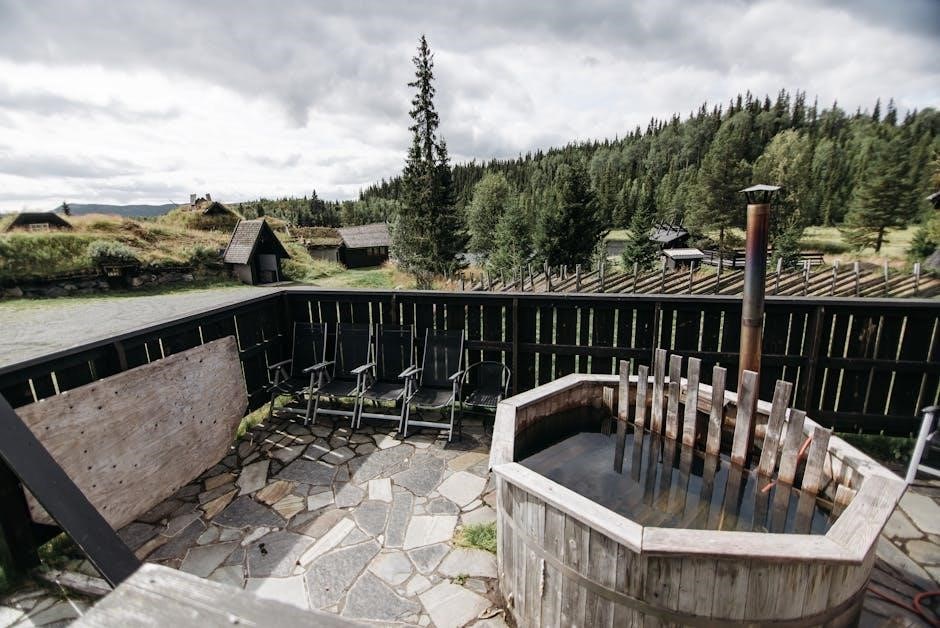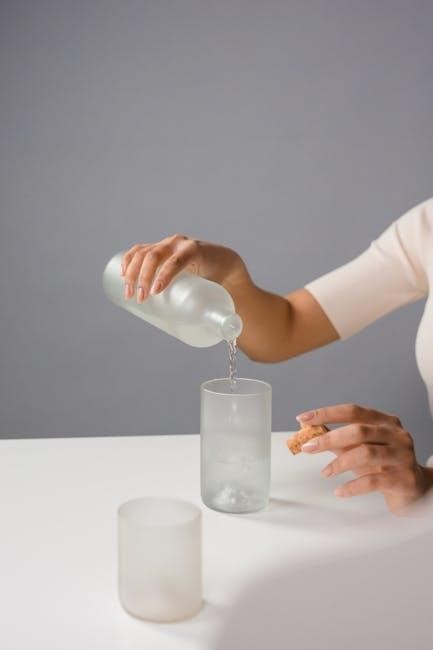Water well pumps are essential devices for extracting water from underground sources, ensuring reliable access to clean water for residential, agricultural, and emergency needs.
What is a Water Well Pump?
A water well pump is a device designed to extract water from an underground well for residential, agricultural, or emergency use. It operates by creating suction or pressure to lift water from beneath the ground surface to the surface. These pumps are typically categorized into manual and submersible types, with manual pumps being ideal for shallow wells and off-grid applications, while submersible pumps are suited for deeper wells and higher water demands. Jet pumps, a common type, are single-stage domestic pumps capable of lifting water up to 90 feet. Deep well pumps often include pressure switches and control valves for efficient operation. Proper installation and maintenance are crucial to ensure reliable performance and longevity of the pump. Regular testing for water purity and temperature is also essential to ensure safe and consistent water supply.
Importance of Water Well Pumps
Water well pumps are vital for providing reliable access to clean water, essential for drinking, irrigation, and household needs. They enable communities, especially in remote areas, to harness underground water resources sustainably. These pumps are crucial for emergency preparedness, offering a backup water supply during power outages or natural disasters. Manual and submersible pumps cater to various depths and flow requirements, ensuring versatility for different applications. By maintaining consistent water pressure and flow, they support agricultural activities and residential comfort. Regular maintenance and proper installation are key to their longevity and efficiency. Moreover, they contribute to water conservation by preventing over-extraction and ensuring optimal resource management. Overall, water well pumps are indispensable for securing and managing water supplies in diverse settings.

Types of Water Well Pumps
Water well pumps include manual, submersible, and jet pumps, each designed for specific depths and flow requirements. Manual pumps are ideal for shallow wells, while submersible pumps handle deep wells and high water demands. Jet pumps are versatile, suitable for both shallow and deep applications, making them a popular choice for residential use.
Manual Well Pumps
Manual well pumps are simple, cost-effective solutions for accessing water from shallow wells, typically up to 25 feet deep. These pumps operate without electricity, making them ideal for off-grid locations, emergencies, or areas with frequent power outages. They are often used in rural settings, farms, and homesteads where reliability and simplicity are key. Manual pumps come in various designs, such as suction pumps and pitcher pumps, and are known for their durability and low maintenance requirements. Popular brands like Simple Pump and Bison Pumps offer high-quality manual options that are easy to install and maintain. These pumps are also environmentally friendly, as they rely on human power rather than electricity. Regular maintenance, such as checking valves and ensuring proper lubrication, ensures long-term functionality. Manual well pumps are a practical choice for those seeking sustainable and self-sufficient water solutions.
Submersible Well Pumps
Submersible well pumps are high-efficiency devices designed for deep wells, typically installed underground and fully submerged in water. These pumps are ideal for wells with depths exceeding 100 feet and are known for their quiet operation and energy efficiency. They are constructed with durable materials, such as stainless steel, to withstand harsh underwater conditions. Submersible pumps are widely used in residential and agricultural settings, providing consistent water pressure and flow. Installation requires careful planning to ensure proper placement below the water level and above the well screen. Regular maintenance involves checking for sediment buildup and ensuring the pump is not exposed to dry running, which can cause damage. These pumps are a reliable choice for long-term water supply solutions, offering both performance and durability.
Shallow Well vs. Deep Well Pumps
Shallow well pumps are designed for wells with water levels up to 25 feet deep, while deep well pumps handle depths exceeding 100 feet. Shallow well pumps are typically jet pumps, suitable for low-pressure applications, and are easier to install and maintain. They are ideal for small homes or farms with minimal water needs. Deep well pumps, often submersible, are more powerful and efficient for higher demands. They are submerged entirely in water, providing consistent pressure and flow. Choosing the right pump depends on the well’s depth and water usage requirements. Proper installation and maintenance are crucial for both types to ensure long-term functionality and water quality.
Installation of Water Well Pumps
Proper installation involves placing the pump below the water level, ensuring the casing is secure, and connecting pipes correctly to avoid sediment and ensure efficient water flow.
Pre-Installation Checks
Before installing a water well pump, several critical checks must be performed to ensure optimal functionality and safety. First, verify the well’s water level and flow rate to determine the appropriate pump size and type. The well casing should be inspected for damage or corrosion to prevent leaks or contamination. Additionally, check the electrical supply to ensure compatibility with the pump’s voltage and power requirements. The surrounding area should be clear of debris, and the pump’s intake must be positioned at least 10 feet above the well’s bottom to avoid sediment. Testing the water quality is also essential to ensure it meets safety standards for consumption or usage. These pre-installation checks help prevent future issues and ensure the pump operates efficiently for years to come.
Step-by-Step Installation Process
Installing a water well pump requires careful planning and execution. Begin by preparing the well casing and ensuring all necessary components, such as pipes and fittings, are ready. For submersible pumps, lower the pump and motor assembly into the well, securing it to the discharge pipe. Connect the electrical wiring to the control box and ensure all connections are watertight. For shallow well pumps, mount the jet pump above ground and connect the suction and discharge pipes to the well. After installation, fill the system with water and test for leaks. Finally, connect the pump to a pressure tank and switch, then run a test cycle to ensure proper operation. Always follow the manufacturer’s instructions and safety guidelines to avoid damage or injury.
Post-Installation Testing
After installing a water well pump, thorough testing is crucial to ensure optimal performance and safety. Begin by checking for leaks in all connections, including pipes, fittings, and electrical components. Activate the pump and monitor its operation for smooth, consistent water flow. Measure the water pressure and flow rate to ensure they meet the system’s specifications. Test the pressure switch to confirm it cycles on and off correctly. For submersible pumps, verify that the motor is operating within the recommended temperature range. Finally, conduct a water quality test by collecting samples and analyzing for purity. Address any issues promptly to prevent long-term damage and ensure reliable water supply.

Maintenance and Repair
Regular maintenance ensures optimal performance and longevity of water well pumps. Inspect for leaks, check electrical connections, and replace worn parts promptly. Lubricate moving components and ensure proper water flow to prevent damage and maintain efficiency.
Regular Maintenance Tasks
Regular maintenance tasks for water well pumps include checking for leaks and ensuring all connections are secure. Inspect the pump’s electrical components and wiring for damage or wear. Lubricate moving parts to reduce friction and prevent overheating. Additionally, monitor water flow rates and pressure to detect potential issues early. Clean or replace filters and screens to maintain water quality and pump efficiency. Schedule annual professional inspections to address any hidden problems. Proper maintenance ensures reliable operation, extends the pump’s lifespan, and prevents costly repairs. Always refer to the manufacturer’s manual for specific guidance tailored to your pump model. Regular upkeep safeguards your water supply and system integrity.
Troubleshooting Common Issues
Troubleshooting common issues with water well pumps involves identifying symptoms and addressing root causes. Low water pressure or no water flow may indicate clogged intake screens, worn valves, or insufficient water levels. Strange noises, such as grinding or rattling, could signal loose parts or sediment buildup. Excessive heat from the motor may point to overloading or poor lubrication. Water hammer, causing pressure surges, can damage pipes and valves. For submersible pumps, check for proper motor cooling and wiring connections. If no water flows, ensure the pump is primed and check for leaks. Always unplug the pump before servicing and follow safety guidelines to avoid injury. Refer to the manual for specific troubleshooting steps and consider professional assistance for complex issues.
Water Quality Testing
Regular water quality testing is crucial to ensure safe and clean water from your well. Test for bacteria, nitrates, pH levels, and dissolved solids annually. High levels of contaminants like arsenic or lead require immediate action. Use certified kits or consult local health departments for accurate results. Maintain records of test outcomes to monitor changes over time. If issues arise, consider filtration systems or treatment solutions. Always follow the pump manual’s guidelines for water testing to ensure optimal performance and safety. Proper testing helps protect both the well system and the health of those using the water.

Safety Precautions
Always disconnect power before servicing pumps to avoid electrical shocks. Handle hot components with care and relieve pressure slowly to prevent scalding or injury from pressurized systems.
Handling Hot Water and Pressurized Systems
When working with water well pumps, it’s crucial to handle hot water and pressurized systems with caution to avoid injuries and equipment damage. Always disconnect the power supply before servicing the pump to prevent electrical shocks. If the pump or its components are hot, allow them to cool down naturally to avoid burns. Pressurized systems require careful handling; relieve pressure gradually by opening a discharge tap to prevent sudden releases of hot water or steam, which can cause severe scalding. Never dismantle a pump while it contains hot or pressurized water, as this can lead to accidents. Additionally, ensure the pump is installed at least 10 feet above the well’s bottom to prevent sediment interference and maintain optimal performance. Always follow the manufacturer’s guidelines for safe operation and maintenance.
Electrical Safety Measures
Ensuring electrical safety is paramount when installing and operating water well pumps. Always disconnect the power supply before performing any maintenance or repairs to prevent electrical shocks. Verify that the pump’s voltage matches the power source to avoid damage or hazards. Use ground fault circuit interrupters (GFCIs) to protect against ground faults, especially in wet environments. Keep electrical components dry and avoid exposing them to water. Regularly inspect wiring and connections for wear or damage, and replace any compromised parts immediately. Never attempt to repair live electrical systems, and always follow the manufacturer’s wiring diagrams and instructions. Additionally, ensure that all electrical installations comply with local codes and regulations to maintain a safe operating environment. Proper electrical safety measures protect both the equipment and the user from potential hazards.
Emergency Procedures
In case of an emergency involving a water well pump, immediate action is required to ensure safety and prevent further damage. First, turn off the power supply to the pump at the electrical panel or breaker box. If the pump is submerged, do not attempt to retrieve it yourself; contact a professional. For overheating or excessive pressure, relieve pressure by opening a tap on the discharge side and allow the system to cool. In case of water contamination, isolate the system and contact a water treatment specialist. Keep emergency contact information, such as a licensed well technician, readily available. Regular inspections and maintenance can help prevent emergencies, but always be prepared with a backup water supply and first aid kit. Safety should never be compromised when dealing with electrical or pressurized systems.

Additional Resources
Explore our Glossary of Terms for detailed explanations of technical phrases. Visit the Pump Manual Library for installation guides and maintenance tips. Check out the Simple Pump Hand Well Pump manual for off-grid solutions.
Glossary of Terms
A collection of key terms and definitions related to water well pumps:
- Submersible Pump: A pump placed below the water level in a well, designed for deep wells and high water demand.
- Jet Pump: A surface-mounted pump that uses suction to draw water from a well, ideal for shallow wells.
- Static Water Level: The natural water level in a well when not being pumped.
- Drawdown: The drop in water level when the pump is operating.
- Foot Valve: A one-way valve installed at the bottom of the well to prevent water from draining back.
- Check Valve: Ensures water flows in one direction, preventing backflow in the system.
These terms are essential for understanding the installation, operation, and maintenance of water well pumps.
Further Reading and Manuals
For comprehensive understanding, explore detailed manuals and guides available online, such as the Goulds Submersible Pump Manual and the Simple Pump Deep Well Hand Pump Manual.
These resources provide in-depth installation, operation, and maintenance instructions, ensuring optimal performance and longevity of your water well pump system.
Additional materials, such as troubleshooting guides and diagrams, are available on manufacturer websites like Hallmark Industries and Bison Pumps.
Visit the Pump Manual Library for preventative maintenance tips and step-by-step repair instructions.
Free downloadable PDFs, such as the Webtrol Pump Installation Manual, offer detailed procedures for submersible and jet pumps.
These resources are regularly updated to reflect the latest advancements in water well technology and safety standards.
Consulting these manuals ensures you can effectively manage and maintain your water well pump system for years to come.
